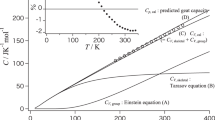Abstract
In this study, the DFT/B3LYP level of theory with the 6-31G (d) basis set was used to calculate a set of quantum chemical descriptors for structure units of vinyl polymers. These descriptors were used to predict the molar heat capacity of “liquid” at constant pressure (C 1 P (298 K)) and the molar Lorentz and Lorenz polarization (P LL). Two more physically meaningful quantitative structure-property relationship (QSPR) models obtained from the training sets applying multiple linear stepwise regression (MLR) analysis were evaluated externally using the test sets. Correlation coefficients between the predicted and the experimental values were: 0.998 for C 1 P (298 K) and 0.979 for P LL. The results indicate that the QSPR models constructed using quantum chemical descriptors can be applied to predict the properties of polymers confirming the role of quantum chemical descriptors in the QSPRs studies of polymers.
Similar content being viewed by others
References
Afantitis, A., Melagraki, G., Sarimveis, H., Koutentis, P. A., Markopoulos, J., & Igglessi-Markopoulou, O. (2006). Prediction of intrinsic viscosity in polymer-solvent combinations using a QSPR model. Polymer, 47, 3240–3248. DOI: 10.1016/j.polymer.2006.02.060.
Becke, A. D. (1993). Density-functional thermochemistry III. The role of exact exchange. The Journal of Physical Chemistry, 98, 5648–5652. DOI: 10.1063/1.464913.
Bicerano, J. (1996). Prediction of polymer properties (2nd ed.). New York: Marcelar Dekker.
Brown, W. M., Martin, S., Rintoul, M. D., & Faulon, J.-L. (2006). Designing novel polymers with targeted properties using the signature molecular descriptor. Journal of Chemical Information and Modeling, 46, 826–835. DOI: 10.1021/ci0504521.
Cao, C. Z., & Lin, Y. B. (2003). Correlation between the glass transition temperature and repeating unit structure for high molecular weight polymers. Journal of Chemical Information and Computer Sciences, 43, 643–650. DOI: 10.1021/ci0202990.
Golbraikh, A., & Tropsha, A. (2002). Beware of q 2!. Journal of Molecular Graphics and Modelling, 20, 269–276. DOI: 10.1016/S1093-3263(01)00123-1.
Karelson, M., Lobanov, V. S., & Katritzky, A. R. (1996). Quantum-chemical descriptors in QSAR/QSPR studies. Chemical Reviews, 96, 1027–1043. DOI: 10.1021/cr950202r.
Katritzky, A. R., Sild, S., Lobanov, V., & Karelson, M. (1998a). Quantitative structure-property relationship (QSPR) correlation of glass transition temperatures of high molecular weight polymers. Journal of Chemical Information and Computer Sciences, 38, 300–3004. DOI: 10.1021/ci9700687.
Katritzky A. R., Sild, S., & Karelson, M. (1998b). Correlation and prediction of the refractive indices of polymers by QSPR. Journal of Chemical Information and Computer Sciences, 38, 1171–1176. DOI: 10.1021/ci980087w.
Kholodovych, V., Smith, J. R., Knight, D., Abramson, S., Kohn, J., & Welsh, W. J. (2004). Accurate prediction of cellular response using QSPR a feasibility test of rational design of polymeric biomaterials. Polymer, 45, 7367–7379. DOI: 10.1016/j.polymer.2004.09.002.
Lee, C., Yang, W., & Parr, R. G. (1988). Development of the Colle-Salvetti correlation-energy formula into a functional of the electron density. Physical Review, B37, 785–789. DOI: 10.1103/PhysRevB.37.785.
Mattioni, B. E., & Jurs, P. C. (2002). Prediction of glass transition temperatures from monomer and repeat unit structure using computational neural networks. Journal of Chemical Information and Computer Sciences, 42, 232–240. DOI: 10.1021/ci010062o.
Morrill, J. A., Jensen, R. E., Madison, P. H., & Chabalowski, C. F. (2004). Prediction of formulation dependence of the glass transition temperatures of amine-eporxy copolymers using a QSPR based on AM1 method. Journal of Chemical Information and Computer Sciences, 44, 912–920. DOI: 10.1021/ci030290d.
Tokarski, J. S., Hopfinger, A. J., Hobbs, J. D., Ford, D. M., & Faulon, J. M. (1997). Molecular modelling of polymers 17. Simulation and QSPR analyses of transport behavior in amorphous polymeric materials. Computational and Theoretical Polymer Science, 7, 199–214. DOI: 10.1016/S1089-3156(98)00007-5.
Tropsha, A., Gramatica, P., & Gombar, V. K. (2003). The importance of being earnest: validation is the absolute essential for successful application and interpretation of QSPR Models. QSAR & Combinatorial Science, 22, 69–77. DOI: 10.1002/qsar.200390007.
van Krevelen, D. W. (1976). Properties of polymers-their estimation and correlation with chemical structure (2nd ed.). Amsterdam: Elsevier.
Xu, J., Chen, B., Zhang, Q. J., & Guo, B. (2004). Prediction of refractive indices of linear polymers by a four-descriptor QSPR model. Polymer, 45, 8651–8659. DOI: 10.1016/j.polymer.2004.10.057.
Yu, X. L., Wang, X. Y., Gao, J. W., Li, X. B., & Wang, H. L. (2005). QSPR studies of polyvinyls by density functional theory. Polymer, 46, 9443–9451. DOI: 10.1016/j.polymer.2005.07.039.
Yu, X. L., Xie, Z. M., Yi, B., Wang, X. Y., & Liu, F. (2007). Prediction of the thermal decomposition property of polymers using quantum chemical descriptors. European Polymer Journal, 43, 818–823. DOI: 10.1016/j.eurpolymj.2006.12.031.
Author information
Authors and Affiliations
Corresponding author
Rights and permissions
About this article
Cite this article
Yu, X., Yi, B., Yu, W. et al. DFT-based quantum theory QSPR studies of molar heat capacity and molar polarization of vinyl polymers. Chem. Pap. 62, 623–629 (2008). https://doi.org/10.2478/s11696-008-0066-3
Received:
Revised:
Accepted:
Published:
Issue Date:
DOI: https://doi.org/10.2478/s11696-008-0066-3




